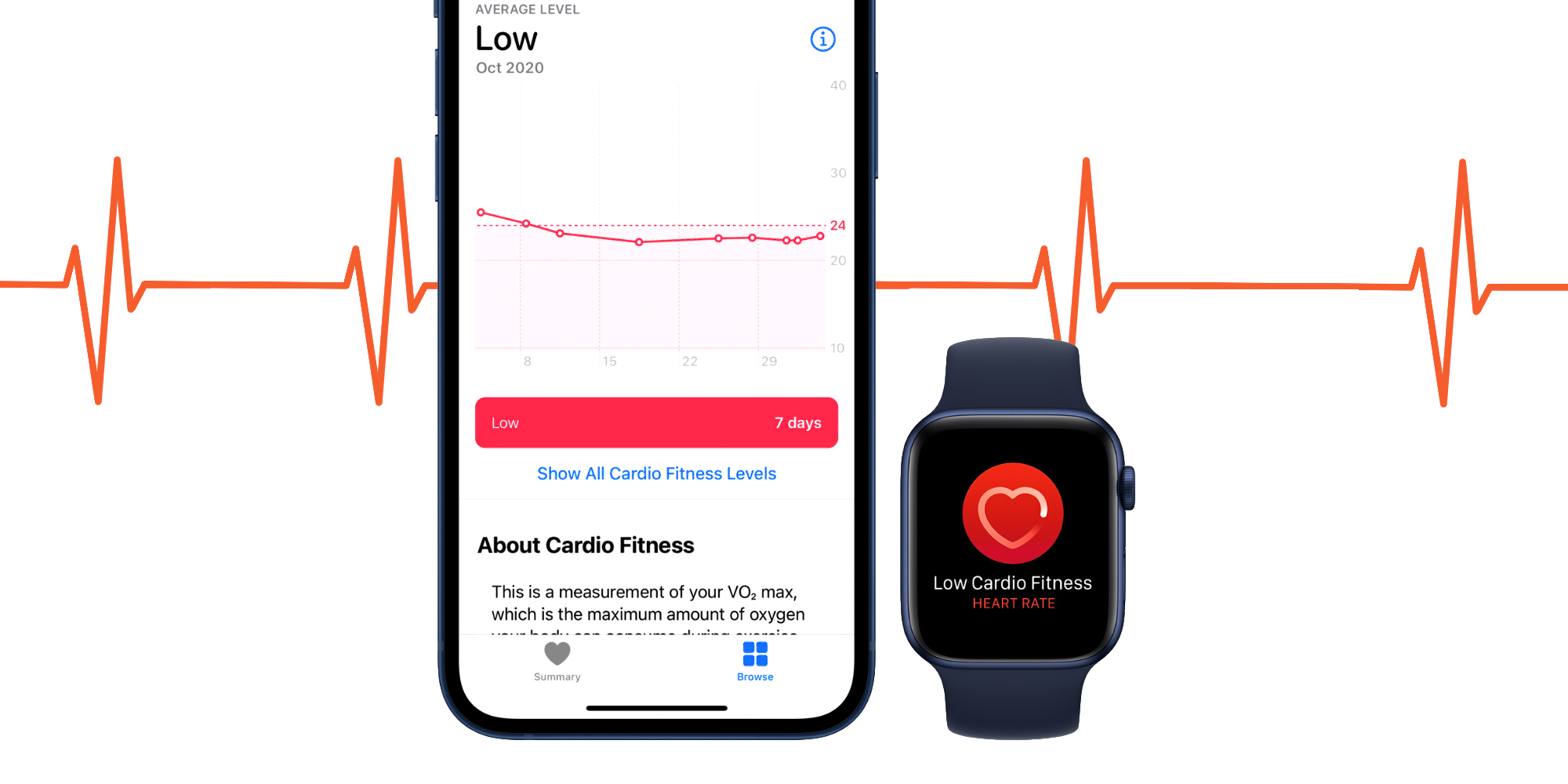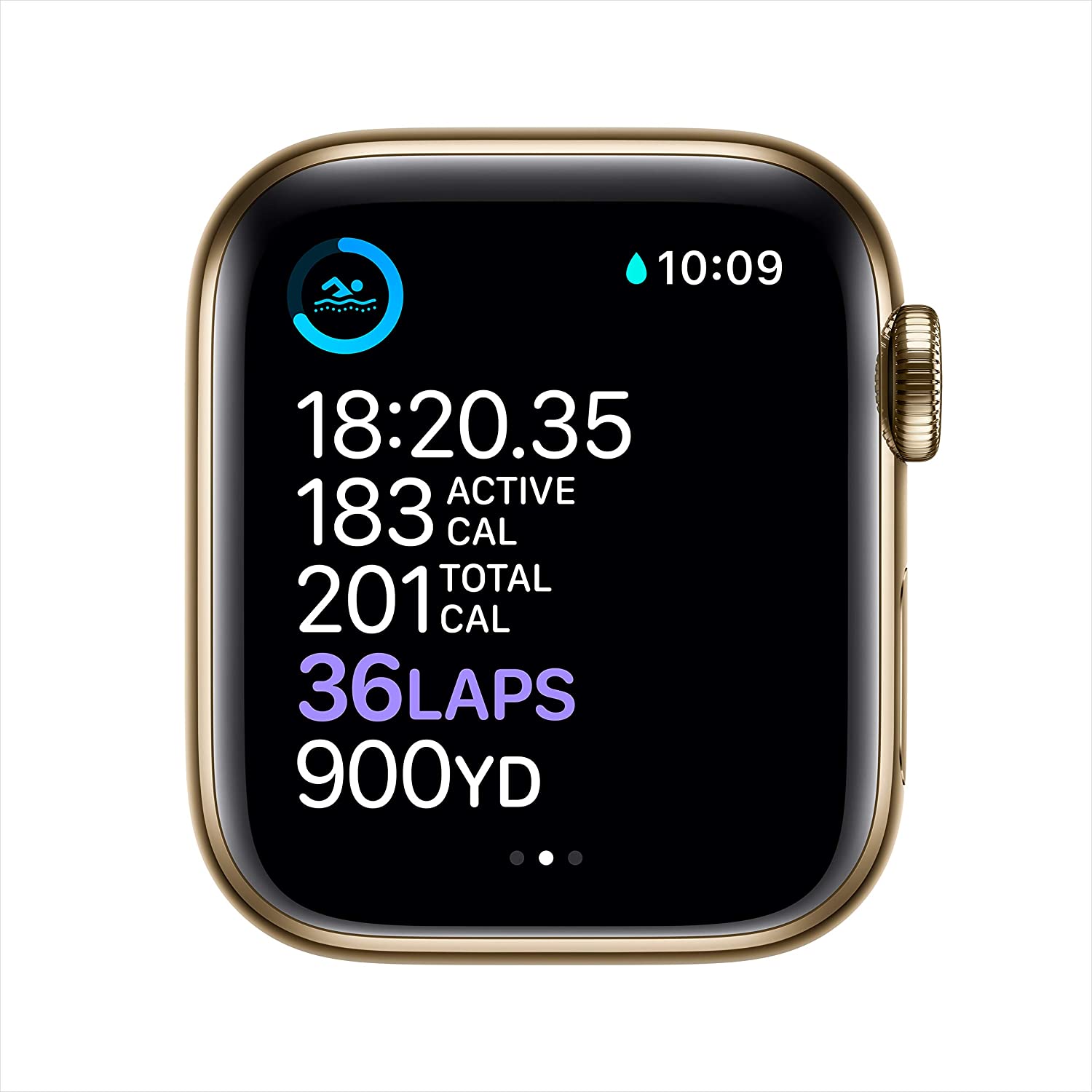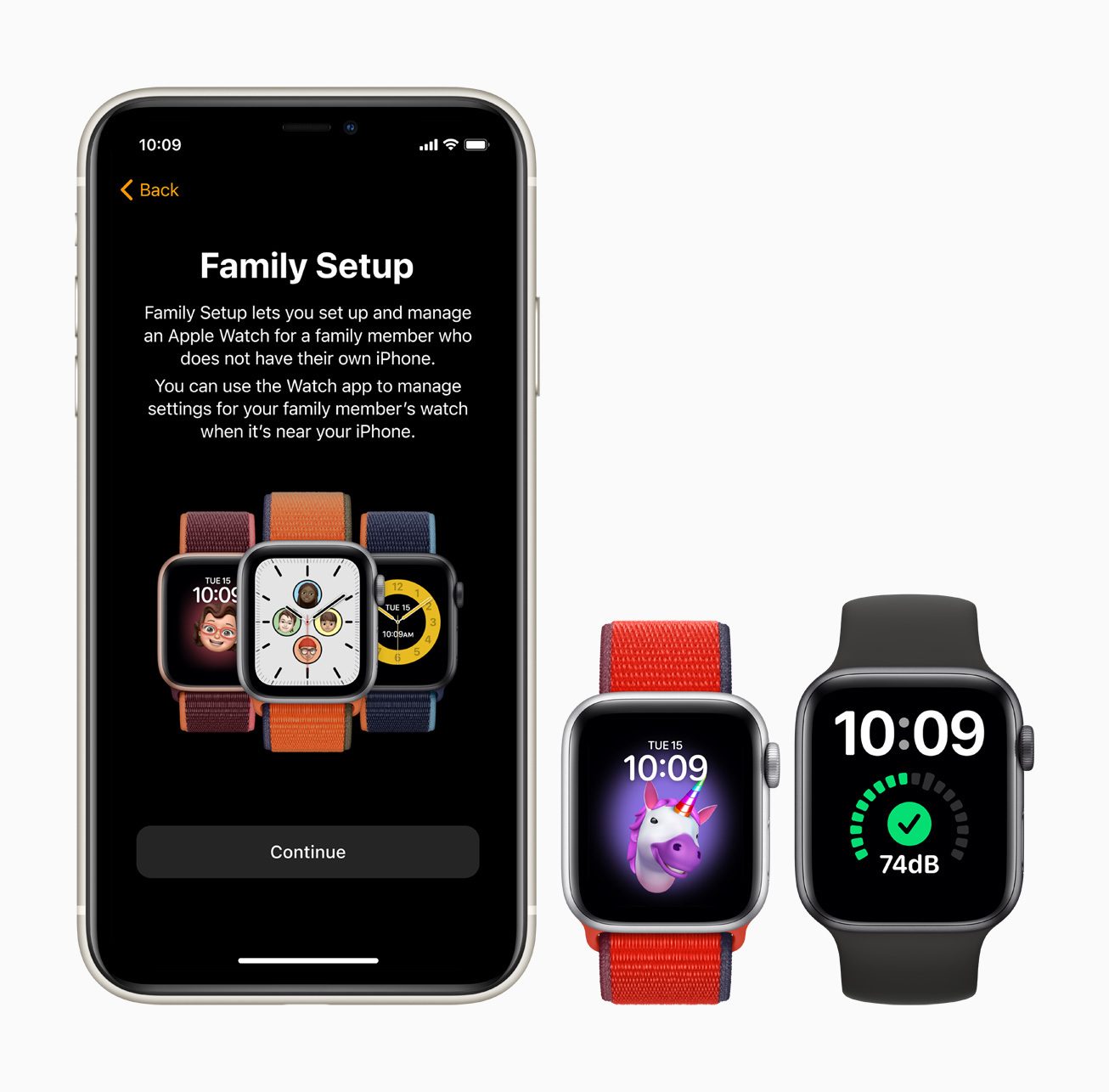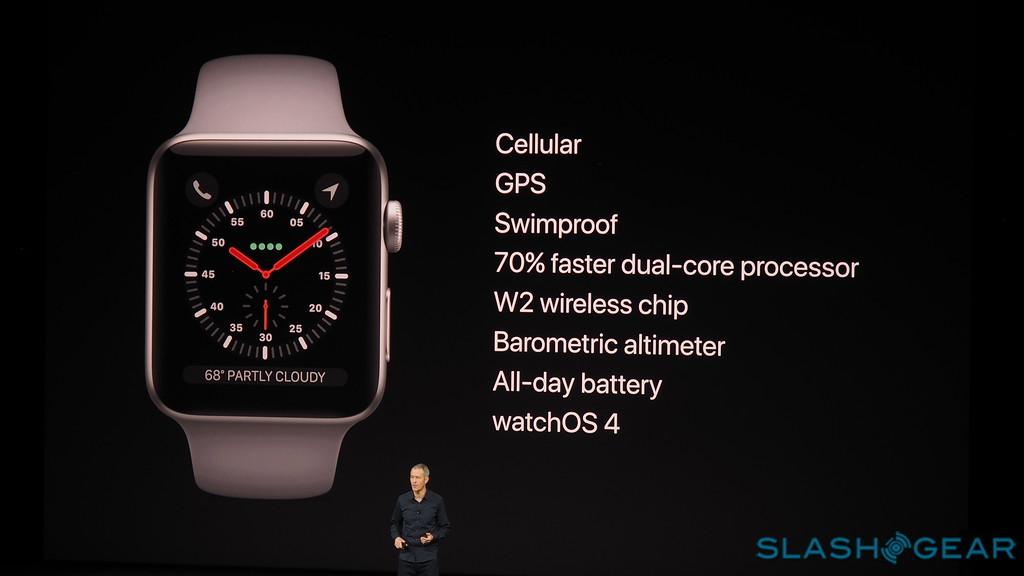The Apple Watch Series 7 offers the same suite of sensors as the Series 6. These include an accelerometer, a gyroscope, a heart rate sensor, a barometer, an always-on altimeter, a compass, an SpO2 sensor, and a VO2 max sensor. These sensors a host of health and fitness tracking features, including blood oxygen monitoring, heart rate monitoring, sleep tracking, fall detection, workout tracking, and more.
Apple today announced Apple Watch Series 7, featuring a reengineered Always-On Retina display with significantly more screen area and thinner borders, making it the largest and most advanced display ever. The narrower borders allow the display to maximize screen area, while minimally changing the dimensions of the watch itself. Apple Watch Series 7 also features a user interface optimized for the larger display, offering greater readability and ease of use, plus two unique watch faces — Contour and Modular Duo — designed specifically for the new device. With the improvements to the display, users benefit from the same all-day 18-hour battery life,1 now complemented by 33 percent faster charging.
Apple Watch Series 6 is water-resistant and supports Apple Pay purchases like previous models, plus it has all the same health-related features in addition to blood oxygen monitoring. The key USP of the Apple Watch product lineup is its health and fitness features. While Apple hasn't provided any significant additions on that front, you're getting most of the commonly available features to track your health and wellness while on the go. The Apple Watch Series 7 offers blood oxygen saturation tracking using a built-in Blood Oxygen sensor.
It is also capable of tracking heart rate using an electrical heart rate sensor that was first introduced on the Apple Watch Series 4 and also available on the last-generation model. The smartwatch can also detect atrial fibrillation and can provide an electrocardiogram report. Additional features include a new S6 processor that is up to 20% faster than the S4 and S5, a 2.5x brighter always-on display, and an always-on altimeter. The Series 6 watch has been updated with faster charging hardware such that it now completes charging in ~1.5 hours. Force Touch hardware was removed, consistent with the removal of all Force Touch functionality from watchOS 7. The Apple Watch Series 7 continues to provide an "all-day" 18-hour battery life from a single charge.
The device can now charge 33 percent faster charging compared with Apple Watch Series 6 thanks to a new charging architecture and Apple's Magnetic Fast Charger USB-C Cable. This means that just eight minutes of charging time can provide up to eight hours of sleep tracking. These include a new flatter display, with slimmer bezels and two new screen sizes.
This means there's space for a full keyboard now, while IP6X dust resistance is added to the existing WR50 waterproofing. You also get significantly faster charging and fall detection while cycling, as well as a new range of colours. The Series 7 is still compatible with existing Apple Watch straps and bands, though. Apple Watch Series 7 offers the same health monitoring features available with the Series 6. A built-in accelerometer and gyroscope enable other important health-related features such as fall detection. The Apple Watch Series 7 deliver 18 hours of battery life but chargers over USB Type-C port, offering 33 percent faster charging than the previous generation.
The Apple Watch Series 7 is made with 100 percent recycled aluminium. It also features a more durable glass that Apple claims is crack resistant, while an IP6X dust-protection rating is added to the WR50 water resistance. The Series 7 has the most crack-resistant glass with IP6X certification for dust resistance and the same water resistance rating, says Apple. One of the biggest gripes for Watch users has been the charging speed. Apple says that with Watch Series 7, it has improved it by 33%.
For instance, 8 minutes of charging can give up to 8 hours of sleep tracking. Also, with just 45 minutes of charging Apple Watch can reach from 0 to 80%. Apple has given USB-C support for Apple Watch and the magnetic charging puck, which has been around for years.
Each model through Series 3 comes in a 38- or 42-millimeter body, with the larger size having a slightly larger screen and battery. The Series 4 has been updated to 40- and 44-millimeter models, respectively. Featured Apple-made bands include colored sport bands, sport loop, woven nylon band, classic buckle, modern buckle, leather loop, Milanese loop, and a link bracelet. There are also two third-party bands, Artenix and Wristcam, which give on-the-go charging capabilities and a built-in camera to the watch, respectively. Note that the altimeter can be inaccurate in some weather conditions.
Apple promises 18 hours of use on a single charge on the Series 7, which means that the smartwatch is still a one-day device only. It's worrying to see the battery life not improve from the last generation, but we'll have to test whether we can have a longer battery life without sacrificing functionality. The watch can go from 0% to 80% charge in just 45 minutes, which is significantly faster than previous generations. The watch also charges via the same magnetic charger, but the cable is now USB-C on the other end, which helps speed things up a little – 33-percent faster to be exact. A new USB-C charging cable supplied with the Apple Watch Series 7 will recharge a depleted watch to 80 percent in 45 minutes.
Eight minutes of charge will add enough battery to endure eight hours of sleep tracking with the built-in Sleep app, Apple says. Apple Watch Series 7 was launched at the company's "California streaming" event on Tuesday. The new Apple Watch model is the eighth iteration in the series of smartwatches launched by the Cupertino giant since its first generation in 2015. The Apple Watch Series 7 comes as a significant upgrade over last year's Series 6, including a major redesign. There are 1.7mm thin borders to maximise display area while barely changing the dimensions of the watch itself.
The addition of the new design also enables the Apple Watch Series 7 to deliver the largest-ever display that comes in the 45 millimetres size variant. Apple claims that using the new design, the Apple Watch Series 7 offers 20 percent more screen area than that of the Apple Watch Series 6, and 50 percent compared to the entry-level Series 3 model. The Series 7 is also equipped with new hardware that enables ultra-rapid, short-range wireless data transfer at 60.5GHz, though Apple has not fully explained this new functionality. It can keep track of the number of laps and distance during Swimming workouts. During swimming, the touch function can be manually disabled with 'Underwater mode'.
Once this is turned off, by rotating the Digital Crown continuously, it uses the speaker to expel residual water through a series of 10 vibrations. Most recently used apps now are saved in the background, so apps and information load faster. The Series 2 was sold in casings of anodized Aluminium, Stainless Steel and Ceramic. But the watch does come with a more advanced charger for 33% faster charging, juicing up from 0% to 80% in 45 minutes. An 8-minute charge meanwhile can supposedly provide 8 hours of sleep tracking.
According to leaks the watch also comes with a new 1-meter USB-C magnetic fast charging cable in the box. The Series 6 contains an S6 System-in-Package chip, which is based on the A13 Bionic in the iPhone 11. It is up to 20 percent faster than the previous generation but still offers the same all-day 18-hour battery life. Apple Watch Series 6 offers faster charging and can be charged to full in 1.5 hours.
Battery life was improved for tracking workouts like indoor and outdoor runs, too. Apple Watch Series 7 models are also able to charge 33 percent faster, with just eight minutes of charging providing up to eight hours of sleep tracking time. There are some tradeoffs with the Apple Watch Series 3 because it is a much older model, such as a smaller display, an older chipset, and the lack of a compass, fall detection, ECG, and blood oxygen monitoring. The Apple Watch Series 7 battery should last as long as the Series 6, but Apple says it cuts down on the time it takes to charge your watch. The Apple Watch Series 7 can charge up to 33% faster than the Apple Watch Series 6. It should take 45 minutes to go from zero to 80%, and 8 minutes of charging should provide 8 hours of sleep tracking.
Apple has taken the wraps off its next-generation smartwatch, Apple Watch Series 7. This new smartwatch represents the biggest shake-up of the design since the Apple Watch range launched back in April 2015. Apple has extended the curved screen so that it bleeds over the edge of the case – maximising the amount of display on your wrist, without substantially increasing the size of the enclosure, compared to the previous generation. It's also more durable, with dust resistance, includes new workout tracking, and lands with new colours. The new Mindfulness app, sleep respiratory rate tracking and Tai Chi and Pilates workout types can help improve overall wellness. It also continues to offer tools for health and wellness, including an electrical heart sensor and ECG app and a blood oxygen sensor app.
Force touch technology has been removed in Watch series 6 and Watch SE. The watch also has a side button which can be used to display recently used apps and access Apple Pay, which is used for contactless payment. The watch then reverts to its original mode when recharged or after holding down the side button. Measure your blood oxygen level with a revolutionary sensor and app. Along with other innovations like mindfulness and sleep tracking to keep you healthy from head to toe. The Apple Watch Series 6 offers a number of other health and fitness features including sleep tracking, automatic hand-washing detection, new workout types, and an overall focus on customers' well-being. Users of the Series 7 can enjoy faster charging speeds, which have improved by 33% offering 8 hours of sleep tracking from just 8 minutes of charging.
The Watch will adopt a new charging method, using USB-C and the current magnetic charging puck, said 9 to 5 Mac. The Apple Watch 7 series brings blood oxygen saturation tracking and heart rate tracking via an electrical heart rate sensor. The watch can also detect atrial fibrillation and can provide an ECG report. It will still pack a lot of helpful features, such as tracking your blood oxygen levels and heart rate, alongside ECG. WatchOS 8 also brings the new Mindfulness app, which will also feature meditation sessions that can be accessed from the Fitness Plus app.
But the smartwatch still has an impressive array of health monitoring features to track ECG, blood oxygen levels, heart rate, and plenty of other metrics. The Apple Watch Series 6 features a rear LED sensor array that can measure oxygen saturation in the blood for a better understanding of fitness and wellness. A custom algorithm included in the Blood Oxygen app measures blood oxygen levels between 70 and 100 percent.
On-demand testing is available through the app, and the watch also occasionally takes background measurements when a person is inactive, including during sleep. Apple bases "all-day" battery life estimates on 90 time checks, 90 notifications, 45 minutes of app use, and a 60-minute workout with music playback via Bluetooth. For LTE models, Apple assumes four hours of LTE connection and 14 hours of connection to an iPhone. In some situations, the Apple Watch will drain faster, such as during calls or workouts. Going with the Apple Watch Series 6 doesn't mean you're going to be sacrificing too much. Aside from the main improvements of a refreshed case and larger screen, the Series 6 and 7 share the same processor alongside a matching array of blood oxygen, heart rate, and other fitness sensors.
So for those who don't need the latest and greatest or don't want to wait until later this year for Series 7 to ship, going with the Apple Watch Series 6 delivers plenty of savings in the meantime. Additionally, cycling workouts have auto-pause and resume, so metrics more accurately reflect time spent moving versus stationary, like waiting at a stoplight." says Apple. The 1st generation Apple Watch uses the single-core S1 system-on-chip. It does not have a built-in GPS chip, instead relying on a paired iPhone for location services. It uses a linear actuator called the "Taptic Engine" to provide haptic feedback when an alert or a notification is received, and is used for other purposes by certain apps.
The watch is equipped with a built-in heart rate sensor, which uses both infrared and visible-light LEDs and photodiodes. All versions of the first-generation Apple Watch have 8 GB of storage; the operating system allows the user to store up to 2 GB of music and 75 MB of photos. When the Apple Watch is paired with an iPhone, all music on that iPhone is also available to be controlled and accessed from the Apple Watch. Software support for the first Apple Watch ended with watchOS 4.3.2. When sleeping, the Apple Watch now measures respiratory rate in addition to time asleep, heart rate, and blood oxygen.
Respiratory data can be viewed in the Health app and is a metric that can be used to track overall wellness. The Apple Watch Series 7, announced in September 2021, is the current iteration of the Apple Watch that originally launched in 2015. The Apple Watch Series 7 builds on the design of previous Apple Watch models with a more rounded design and offers some notable new features including larger displays, improved durability, and faster charging. The stunning display of Apple Watch Series 7 offers nearly 20 percent more screen area and thinner borders at just 1.7 mm — 40 percent smaller than those on Apple Watch Series 6. Through an innovative design that maximizes the screen area while minimally changing the dimensions of the overall case size, Apple Watch Series 7 is available in 41mm and 45mm sizes.
While the wrist is down, the Always-On Retina display is up to 70 percent brighter indoors than that of Apple Watch Series 6, making it easier to see the watch face without having to lift the wrist or wake the display. According to Apple, the Watch Series 7 will be able to get 8 hours of battery life from 8 minutes of charging. That's actually quite useful, and you won't want to overlook it. If you've ever experienced waking up to your watch not being charged, it's great to know you can get a full workday's worth of battery in less than the time it takes to get ready to leave. Its features include sleep tracking, advanced workout tracking, an above-average battery life, and an ECG sensor to diagnose atrial fibrillation.
For any new Apple Watch user aged 18 to 55, fall detection turns on automatically for workouts. Existing users can toggle the feature on themselves in the settings app on the watch or phone or from the Health checklist. Beyond this, the Apple Watch Series 7 will have many of the same health and fitness features we are used to seeing in Apple's smartwatches.
This includes the infamous activity rings, sleep tracking and various ways to track your workouts. You could also choose to keep this feature turned off if you want to maximize battery life, and Apple hasn't said whether the brighter always-on screen will affect the watch's power consumption. I wear an Apple Watch Series 6 daily and regularly leave the always-on display activated, and my watch typically makes it through a full day with a bit of juice left over in the morning. But battery life will always vary depending on your usage, and activities like using GPS connectivity while running will likely cause it to drain faster. When using the Apple Watch, some users have reported issues using the heart monitoring feature due to permanent skin conditions including tattoos.
The Watch uses photoplethysmography technology which utilizes the green LED lights to measure heart rates. To gauge a user's heart rate, the watch flashes green light from the LEDs at the skin and records the amount of this light that is absorbed by the red pigment of the blood. However, under certain circumstances the skin may not allow for the light absorption to be read properly and thus provide inaccurate results. It introduced support for Nightstand mode in portrait orientation. It brought back the ability for music playing on the iPhone to be controlled using the Music app on the Apple Watch and also enabled control of playback and volume on Apple's HomePod. Other new features included a new charging animation and a new app loading animation.
Activity data was added to the Siri watch face, and the battery complication more accurately reports battery life. The ECG system has received clearance from the United States Food and Drug Administration, a first ever for a consumer device, and is supported by the American Heart Association. This device can also detect falls and will automatically contact emergency services unless the user cancels the outgoing call. The microphone was moved to the opposite side between the side button and the digital crown to improve call quality.
Other changes include the digital crown incorporating haptic feedback with the Apple Haptic Engine and includes the new Apple-designed W3 wireless chip. In comparison to other Apple products and competing smartwatches, marketing of the Apple Watch promoted the device as a fashion accessory. Apple later focused on its health and fitness-oriented features, in an effort to compete with dedicated activity trackers. The watchOS 3 added fitness tracking for wheelchair users, social sharing in the Activity app, and a Breathe app to facilitate mindfulness. The Apple Watch 7 does get a 70% brighter Always-On display while indoors, IP6X dust resistance, the same WR50 water resistance as prior models, and more durability.
The display dims when the wrist is down in order to preserve battery life, but key features like watch hands remain illuminated all the time. Touching the watch face or raising the wrist brings the display back to full brightness, and to minimize battery drain, Apple has optimized watch faces for the feature. The Apple Watch's display also has a variable refresh rate that drops from 60Hz to as low as 1Hz when the watch is inactive. The primary health feature that ties to every health and fitness metric is heart rate. The infrared sensor on the back of the Apple Watch regularly measures heart rate and records its findings in the Health app. The user interface is optimized to take advantage of the shape and size of the new display.































No comments:
Post a Comment
Note: Only a member of this blog may post a comment.